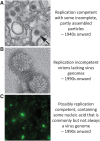Virus-Like Particle: Evolving Meanings in Different Disciplines
- PMID: 36148434
- PMCID: PMC9041479
- DOI: 10.1089/phage.2020.0026
Virus-Like Particle: Evolving Meanings in Different Disciplines
Abstract
Virus-like particle (VLP) is a term that has been in use for about 80 years. Usually, VLP has meant a particle that is like a virus, generally by appearance, but without either proven or actual virus functionality. Initially VLP referred to particles seen in electron microscope images of tissues. More recently, VLP has come to mean other things to other researchers. A key divergence has been use of VLP in association with vaccine and biotechnology applications versus use of VLP in enumeration of viruses in environmental samples. To these viral ecologists, a VLP is a particle that is virus sized, has nucleic acid, and could be a functional virus. But to vaccine developers and biotechnology researchers a VLP instead is a viral structure that intentionally lacks a viral genome. In this study, we look at the history of use of VLP, following changes in meaning as the technology to study VLPs changed.
Keywords: direct counts; electron microscopy; environmental virology; medical microbiology; phage ecology; vaccine.
Copyright 2021, Mary Ann Liebert, Inc., publishers.
Conflict of interest statement
No competing financial interests exist.
Figures

Similar articles
-
A 3.0-Angstrom Resolution Cryo-Electron Microscopy Structure and Antigenic Sites of Coxsackievirus A6-Like Particles.J Virol. 2018 Jan 2;92(2):e01257-17. doi: 10.1128/JVI.01257-17. Print 2018 Jan 15. J Virol. 2018. PMID: 29093091 Free PMC article.
-
Dengue-2 virus-like particle (VLP) based vaccine elicits the highest titers of neutralizing antibodies when produced at reduced temperature.Vaccine. 2018 Nov 29;36(50):7728-7736. doi: 10.1016/j.vaccine.2018.10.072. Epub 2018 Oct 28. Vaccine. 2018. PMID: 30377067
-
Development of Virus-Like-Particle Vaccine and Reporter Assay for Zika Virus.J Virol. 2017 Sep 27;91(20):e00834-17. doi: 10.1128/JVI.00834-17. Print 2017 Oct 15. J Virol. 2017. PMID: 28794019 Free PMC article.
-
Current status and future directions of fish vaccines employing virus-like particles.Fish Shellfish Immunol. 2020 May;100:49-57. doi: 10.1016/j.fsi.2020.02.060. Epub 2020 Mar 1. Fish Shellfish Immunol. 2020. PMID: 32130976 Review.
-
Virus-like particles in vaccine development.Expert Rev Vaccines. 2010 Oct;9(10):1149-76. doi: 10.1586/erv.10.115. Expert Rev Vaccines. 2010. PMID: 20923267 Review.
Cited by
-
RNA Phage VLP-Based Vaccine Platforms.Pharmaceuticals (Basel). 2021 Aug 4;14(8):764. doi: 10.3390/ph14080764. Pharmaceuticals (Basel). 2021. PMID: 34451861 Free PMC article. Review.
-
Virus-like Particles for TEM Regulation and Antitumor Therapy.J Funct Biomater. 2022 Dec 17;13(4):304. doi: 10.3390/jfb13040304. J Funct Biomater. 2022. PMID: 36547564 Free PMC article. Review.
-
The Role of Plant Virus-like Particles in Advanced Drug Delivery and Vaccine Development: Structural Attributes and Application Potential.Viruses. 2025 Jan 23;17(2):148. doi: 10.3390/v17020148. Viruses. 2025. PMID: 40006903 Free PMC article. Review.
-
Potential Application of Self-Assembled Peptides and Proteins in Breast Cancer and Cervical Cancer.Int J Mol Sci. 2023 Dec 2;24(23):17056. doi: 10.3390/ijms242317056. Int J Mol Sci. 2023. PMID: 38069380 Free PMC article. Review.
-
Respiratory Viruses and Virus-like Particle Vaccine Development: How Far Have We Advanced?Viruses. 2023 Jan 30;15(2):392. doi: 10.3390/v15020392. Viruses. 2023. PMID: 36851606 Free PMC article. Review.
References
-
- Burnet FM. Specific agglutination of bacteriophage particles. Br J Exp Pathol. 1933;14(5):302–308.
-
- Eagles GH, Bradley WH. The agglutination of suspensions of virus-like particles prepared from exudates in acute rheumatic fever. Int J Med. 1939;8(2):173–184.
-
- Claude A, Porter KR, Pickels EG. Electron microscope study of chicken tumor cells. Cancer Res. 1947;7(7):421–430.
LinkOut - more resources
Full Text Sources
